Based on a conversation with and information provided by Lindsey Yourman, M.D.
Click here to download the poster.
Listen to the related podcast.
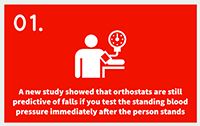
Orthostats: A new study showed that orthostats are still predictive of falls if you test the standing blood pressure immediately after the person stands (as opposed to waiting 3 minutes).
Juraschek SP, Daya N, Rawlings AM, et al. Association of History of Dizziness and Long-term Adverse Outcomes With Early vs Later Orthostatic Hypotension Assessment Times in Middle-aged Adults. JAMA Intern Med. 2017;177(9):1316-1323. doi:10.1001/jamainternmed.2017.2937
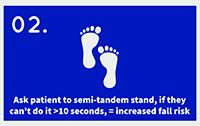
Gait and balance:
Ask patient to semi-tandem stand, if they can't do it > 10 seconds, = increased fall risk.
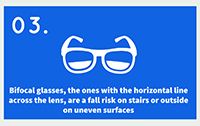
Vision: Bifocal glasses, the ones with the horizontal line across the lens, are a fall risk on stairs or outside on uneven surfaces. Consider recommending the patient see their ophthalmologist to inquire about single distance lenses or take their glasses off when going up or downstairs.
Johnson L, Buckley JG, Scally AJ, Elliott DB. Multifocal spectacles increase variability in toe clearance and risk of tripping in the elderly. Invest Ophthalmol Vis Sci. 2007;48(4):1466-1471. doi:10.1167/iovs.06-0586
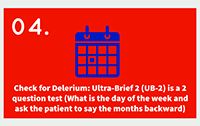
Cognition: Ultra-Brief 2 (UB-2) is a 2 question test (What is the day of the week and ask the patient to say the months backward) with 86% sensitivity and 69% specificity for delirium that has been evaluated in the GED. Evaluate and treat delirium if possible. Delirium prevention (mobility assistance, medication review, paying attention to whether a patient can hear or see) also helps prevent falls.
Fick DM, Inouye SK, Guess J, et al. Preliminary Development of an Ultrabrief Two-Item Bedside Test for Delirium. J Hosp Med. 2015;10(10):645-650. doi:10.1002/jhm.2418
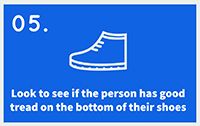
Functional Status: Look to see if the person has good tread on the bottom of their shoes; if not, recommend new shoes if they can afford it.
Prevent Falls With Proper Shoes for Seniors. Sweating Seniors. August 2018. https://www.sweatingseniors.com/active-seniors/prevent-falls-with-proper-shoes-for-seniors/. Accessed May 22, 2019.
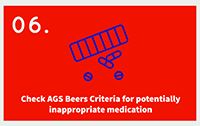
Medications: Check the patient's medications against the American Geriatric Society Beers Criteria for potentially inappropriate medication use in older adults
A website deprescribing.org gives useful tips for how to decrease or discontinue meds including benzos; might have some useful materials for discharge instructions (that a nurse or pharmacist could go through with patient).
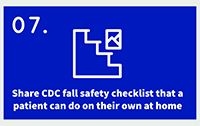
Home Hazards: Provide the CDC fall safety checklist that a patient can do on their own at home
Other CDC Resources: https://www.cdc.gov/steadi/